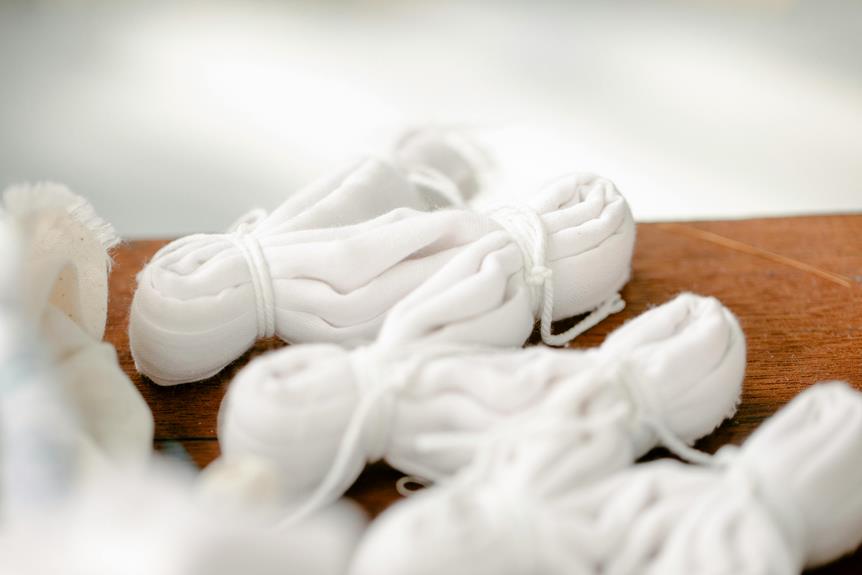When you're ready to sew with voile fabric, it's important to approach it with care due to its lightweight and sheer characteristics. You'll want to start by pre-washing and pressing your fabric to ensure you're working with a clean slate. Choosing the right needle and thread can make all the difference, as can the techniques you employ while cutting and sewing. But what about the specific methods that can help you achieve a polished finish without the usual pitfalls? Understanding these nuances will elevate your sewing experience and lead to impressive results.
Table of Contents
Understanding Voile Fabric
Understanding voile fabric is essential for achieving beautiful, lightweight garments that flow gracefully. Voile is a sheer, delicate fabric typically made from cotton or a cotton blend, offering a soft drape and airy feel. You'll love its versatility, as it works well for various projects, including dresses, blouses, and curtains.
When you work with voile, keep in mind its lightweight nature. It can easily shift and slide, making it crucial to handle it with care during cutting and sewing. A good tip is to use a sharp needle, often a size 60/8 or 70/10, to prevent snagging the fibers. You may also want to consider using a straight stitch or a narrow zigzag stitch to maintain the fabric's integrity.
Additionally, pre-washing your voile is a must. This helps to remove any sizing and pre-shrink the fabric, ensuring your final garment maintains its intended shape.
Essential Tools for Sewing
To achieve the best results when sewing with voile fabric, you'll need a few essential tools that will make your project smoother and more enjoyable.
First, invest in a good quality sewing machine with a fine needle, ideally a size 70/10, as it'll help prevent snagging. A pair of sharp fabric scissors is crucial for clean cuts, ensuring your edges remain neat.
You'll also want to keep a rotary cutter and mat handy, as these can speed up your cutting process. Use a lightweight iron for pressing; steam will help you manage those delicate seams.
Don't forget to have pins or fabric clips on hand. Fabric clips are particularly useful with voile, as they won't leave holes like traditional pins.
A measuring tape and ruler are vital for accurate dimensions, while tailor's chalk or fabric marking pens can help you trace patterns without damaging the fabric.
Finally, consider a seam ripper for any inevitable mistakes. With these tools in your arsenal, you'll be well-prepared to tackle your sewing project with confidence and ease.
Happy sewing!
Preparing the Fabric
Before you start sewing, it's important to properly prepare your voile fabric to ensure the best results.
First, wash your fabric to remove any chemicals from manufacturing. Use cold water and a gentle cycle, then air dry or tumble dry on low. This pre-washing step helps prevent shrinking later on.
Next, press your fabric to eliminate any wrinkles. Set your iron to a low heat setting, as high temperatures can damage the delicate fibers. Always test a small corner first to avoid any mishaps.
Once your fabric is clean and smooth, it's time to cut. Lay your voile flat on a clean, large surface and use a rotary cutter or sharp scissors for precise cuts. Make sure to align your fabric grain properly, as this affects the drape and flow of your finished project.
Choosing the Right Needle
Selecting the right needle is crucial for sewing voile fabric, as it directly impacts the quality of your stitches and the overall finish of your project. Voile is lightweight and delicate, so you'll want to choose a needle that complements these characteristics.
A universal needle, typically sized 60/8 or 70/10, works well for most voile fabrics. These sizes are fine enough to prevent snagging but strong enough to handle the fabric's weave.
If you're working with particularly sheer or lightweight voile, consider using a microtex or sharp needle. These needles have a thin, tapered point that allows for precise stitching without damaging the fabric. Avoid using a heavy needle, as it can create large holes and distort the fabric.
You may also want to pay attention to the needle's type. For sewing seams, a regular point is fine, but if you're adding decorative elements or topstitching, a double needle can provide a lovely finish.
Always remember to change your needle regularly, especially when working with delicate fabrics, to ensure the best results. By choosing the right needle, you'll enhance your sewing experience and achieve beautifully finished projects.
Techniques for Cutting
When you're cutting voile fabric, having the right tools is essential for clean edges.
You'll want to prepare the fabric properly before making any cuts, so it stays manageable.
Let's go over some effective cutting techniques to ensure your project turns out beautifully.
Tools for Cutting Voile
Using sharp, specialized scissors or a rotary cutter will ensure clean edges when cutting voile fabric. Since voile is lightweight and can easily shift, you need tools that provide precision. For scissors, invest in a pair that's specifically designed for delicate fabrics. They'll glide through the voile without snagging or pulling.
If you choose a rotary cutter, opt for a blade with a smaller diameter. This allows for tighter turns and more control, helping you achieve smooth curves and straight lines. Make sure to use a cutting mat to protect your surfaces and keep your blades sharp.
You'll also want to use fabric weights or pins to hold the fabric in place while you cut. This prevents any unwanted movement that could lead to uneven edges. If you're cutting multiple layers, consider using a rotary cutter over scissors to maintain accuracy and speed.
Preparing Fabric Edges
After cutting your voile fabric, preparing the edges properly will help prevent fraying and ensure a clean finish for your projects.
Start by using pinking shears, which create a zigzag edge that reduces fraying while adding a decorative touch. If you don't have pinking shears, you can also use a serger or overlock machine, which encloses the raw edge in thread, providing a sturdy finish.
Another method is to use a straight stitch along the edge of the fabric. Set your sewing machine to a narrow straight stitch and sew approximately 1/8 inch from the edge. This will help hold the fibers in place and minimize fraying. For extra security, consider applying a thin line of fabric adhesive or a fray-check solution before sewing.
You might also want to fold the edges under about 1/4 inch and press them with an iron for a clean finish. This technique not only keeps the edges tidy but also gives your project a professional look.
Whichever method you choose, taking the time to prepare your fabric edges will make a noticeable difference in the quality of your sewing project.
Cutting Techniques Overview
To achieve precise cuts on voile fabric, it's essential to employ the right techniques that ensure accuracy and minimize fraying. Using the correct tools and methods will help you maintain clean edges and a professional finish.
Here are some effective cutting techniques to consider:
- Sharp Fabric Scissors: Invest in high-quality, sharp scissors specifically designed for fabric. This ensures smooth cuts and reduces the risk of snagging.
- Rotary Cutter: A rotary cutter can be a game-changer for voile. It allows you to cut through multiple layers with ease and precision, giving you clean lines.
Before you start cutting, always measure twice and cut once. Lay your fabric flat to avoid any wrinkles or distortions that might affect your cuts.
With these techniques in mind, you'll be well on your way to mastering cutting voile fabric like a pro. Remember, precision is key, and a little preparation goes a long way!
Best Sewing Practices
When sewing with voile fabric, it's essential to choose the right needle and thread to ensure smooth stitching and prevent snags. Opt for a fine needle, like a size 70/10 or 80/12, which will glide through the delicate fibers without causing damage. For thread, use a lightweight, high-quality cotton or polyester that matches your fabric's weight.
Before you start stitching, always pre-wash and iron your voile to remove any sizing and ensure it behaves predictably. Use a straight stitch for most seams, and consider a French seam for a clean finish, as it encloses the raw edges effectively. If you're using a sewing machine, adjust the tension settings to accommodate the lightweight fabric, preventing puckering.
Take your time while sewing, and don't rush. Pinning your pieces securely can help maintain alignment and prevent shifting as you sew. If you encounter any slipping, try using a walking foot, which feeds the layers evenly.
Lastly, always test your stitching on a scrap piece of voile—this way, you can fine-tune your settings before tackling your main project. By following these practices, you'll enjoy a smoother sewing experience with your voile fabric.
Finishing Your Project
Finishing your project with voile fabric requires careful attention to detail to ensure a polished look. Once you've completed the main sewing, take a moment to focus on those finishing touches that can elevate your work.
First, consider your seams. Since voile is lightweight and delicate, using French seams can give your project a clean finish while preventing fraying.
Next, think about hems. A narrow hem works beautifully with voile, providing a subtle yet refined edge.
Finally, don't forget about pressing. Gently press your seams and hems, but be cautious with the heat setting to avoid scorching the fabric.
Here's a quick checklist to guide you:
- Use a lightweight interfacing for added structure in areas like collars or cuffs.
- Add a decorative stitch along the hem for a touch of flair—think scallops or zigzags!
Frequently Asked Questions
Can I Machine Wash Voile Fabric After Sewing?
Yes, you can machine wash voile fabric after sewing, but it's best to wash it on a gentle cycle with cold water. Always check the care instructions to ensure your fabric maintains its quality.
Is Voile Suitable for Beginners in Sewing?
Yes, voile's lightweight nature makes it suitable for beginners. You'll find it easy to handle, but practice is essential. Start with simple projects, and you'll gain confidence in your sewing skills as you progress.
What Types of Garments Are Best for Voile?
Voile's lightweight and airy nature makes it perfect for flowy garments. You'll love using it for summer dresses, blouses, and skirts. It drapes beautifully, giving your creations an elegant, breezy feel that's great for warm weather.
How Does Voile Compare to Other Lightweight Fabrics?
Voile is softer and sheerer than many lightweight fabrics, offering a delicate drape. Unlike cotton lawn, it's more breathable, making it ideal for warm weather. You'll find it perfect for flowy garments and layering options.
Can I Use Voile for Home Décor Projects?
Absolutely, you can use voile for home décor projects! Its lightweight nature creates a soft, airy feel, perfect for curtains or decorative pillows. Just remember to handle it gently to avoid fraying. Enjoy your crafting!
- Tetron Fabric for Marine Applications: Durability and Use Cases - June 18, 2025
- Tetron Fabric for Outdoor Furniture: Weather Resistance and Care - June 18, 2025
- Tetron Fabric for Wall Coverings: Style and Application Tips - June 18, 2025






